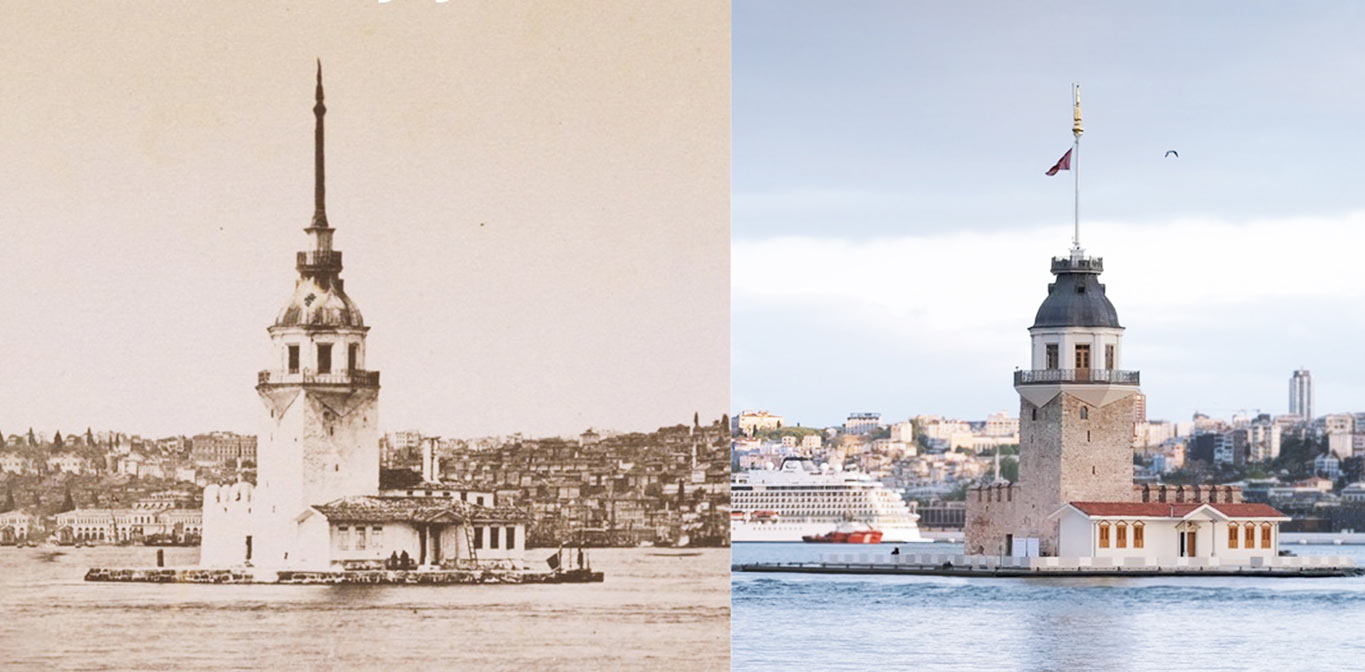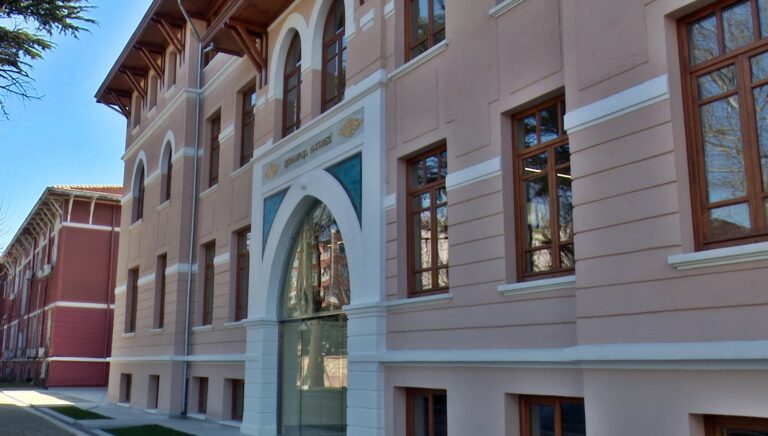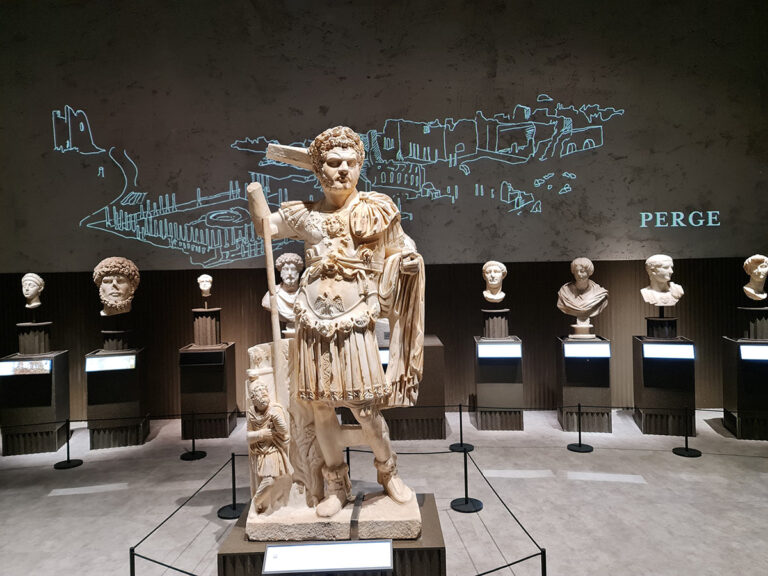Maiden’s Tower History, Exhibits, Entrance Fee, and Visiting Hours
The history of the Maiden’s Tower, also known as Kız Kulesi, spans a rich and varied past from the 5th century BC to the present day. Initially thought to be used as a customs point for controlling and taxing ships coming from the Black Sea, the islet saw the construction of a defense tower in the 12th century by Byzantine Emperor Manuel I Komnenos. This tower was connected by a chain to another tower at Sarayburnu for controlling the entrance and exit of ships in the Bosphorus.
After the conquest of Istanbul in 1453, Sultan Mehmet the Conqueror built a new fortress on the site and stationed a guard unit there. Between 1660 and 1730, a lighthouse was added to the northern part of the wooden tower, marking its transition to a lighthouse.
From 1830 to 1837, the tower’s function changed again, serving as a quarantine hospital during cholera outbreaks. In 1857, a French company added a new lighthouse to the tower.
In the 20th century, the tower underwent several more transformations. In 1926, it became part of the Istanbul Port Authority, serving both as a lighthouse and a gas depot. In 1959, it was used as a radar station, and in 1964, it became an observation and radar station under the Ministry of National Defense. From 1983 to 1992, the tower was transferred to Turkish Maritime and Port Management and was also used as a cyanide depot. In 1992, it was declared a “Poetry Republic” by poets and was transferred to the Naval Forces Command in 1994.
Following an extensive restoration process, it was leased to a private enterprise for tourism purposes from 2000 onwards.
The tower has been known by several names throughout history. In antiquity, it was called “Damalis” and “Arcla” (Little Castle), in the 15th century as “Arcona Tower” in Buondelmonti’s map, in the 17th century as “Tour de Leandre” (Leander’s Tower) in Grelot’s drawing, and in the 18th century as “Kule-i Duhter” and “Üsküdar Kurbunda Vaki Kule-i Bahir”.
The legends surrounding Istanbul’s Maiden’s Tower (Kız Kulesi) are as captivating as the tower itself, each adding a layer of mystique and romance to this iconic structure.
- The King’s Daughter Legend: This is perhaps the most famous legend associated with the tower. It tells of a king who, heeding a fortune-teller’s prophecy that his daughter would die from a snake bite, isolates her in a tower built off the cliffs of Salacak to protect her. Despite his efforts, fate intervenes when a snake, hidden in a basket of fruit sent to the princess, bites and poisons her, leading to her tragic death. This story is a poignant reminder of the inevitability of fate and has become synonymous with the Maiden’s Tower.
- Battal Gazi Legend: Another tale involves the legendary warrior Battal Gazi. In this story, a Byzantine feudal landlord, feeling threatened by Battal Gazi’s presence, hides his treasures and daughter in the tower. Battal Gazi, however, captures the tower, seizing both the treasures and the princess, and famously rides off to Üsküdar. This event is believed to be the origin of the Turkish saying “Atı alan Üsküdar’ı geçti,” which means “What is past, is past.”
- Leandros Legend: The earliest recorded legend about the Maiden’s Tower comes from Ovidius. It narrates the tragic love story of Hero, a nun in the Temple of Aphrodite in Sestos, and Leandros of Abydos. Leandros swims across the strait every night to see Hero, but one stormy night, the lantern in the tower goes out, causing him to lose his way and drown. Upon finding his lifeless body, Hero commits suicide. This tale, originally set in Çanakkale, became linked to the Maiden’s Tower in the 18th century, leading Europeans to refer to it as “Tour de Leandre” or “Leander’s Tower.”
- The Galata Tower and the Maiden’s Tower Love Affair: This is a more whimsical legend, personifying the two iconic towers of Istanbul. The Maiden’s Tower, portrayed as lonely and elegant, falls in love with the imposing Galata Tower. Separated by the Bosphorus, their love is unattainable, yet it blossoms through letters and poems, especially when Ahmet Çelebi, attempting to fly from Galata Tower to Üsküdar, carries the Galata Tower’s letters. This story symbolizes an unfulfilled yet beautiful love and has become part of Istanbul’s romantic lore.
These legends, rich in symbolism and emotion, have contributed significantly to the allure and mysticism of the Maiden’s Tower, making it not just a historical monument but a symbol of love, fate, and the vibrant culture of Istanbul.
Visitors to Istanbul’s iconic Maiden’s Tower can enjoy different access options depending on whether they have a Museum Pass Türkiye or not.
- For Museum Pass Türkiye Holders:
- Entrance to Maiden’s Tower: Free of charge.
- Transportation Fee: A fee of 50 TL is still required for transportation.
- Museum Pass Türkiye: This pass offers free or discounted access to many museums and historical sites across Turkey, including the Maiden’s Tower.
- For Visitors Without a Museum Pass Türkiye:
- Maiden’s Tower Entrance Ticket: 550 TL.
- Maiden’s Tower Transportation Fee: 50 TL.
- Total Fee: 600 TL.
Visiting Hours:
- The Maiden’s Tower is open daily from 09:00 to 18:00.
Transportation to the Maiden’s Tower:
- Visitors can reach the tower via private boats.
- From Üsküdar-Salacak Pier: Boats depart in front of the Maiden’s Tower ticket office between 09:00 – 19:00 every day.
- From Galataport İstanbul Pier: The boat schedule to the Maiden’s Tower is as follows:
- Departures at 11:00, 12:30, 14:15, 15:30, and 17:00.
- Note: The 17:00 boat does not return to Galataport İstanbul.
These options provide flexibility for both local and international visitors to explore this historical and culturally significant site in Istanbul. The Maiden’s Tower, with its rich history and legends, offers a unique experience against the backdrop of the beautiful Bosphorus.




